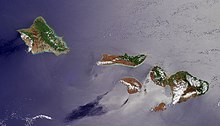Island chain
An island chain is a group of islands in which the individual islands are lined up along an imaginary straight or curved line.
Usually a chain of islands is of volcanic origin. If the island chain is at the edge of a subduction zone , it is generally an island arc . Straight chain of islands are mostly created by the drifting of a lithospheric plate over a hot spot , as a result of which volcanoes repeatedly formed over the course of time, which drifted away and became extinct. The Hawaiian Islands are the prime example of such a chain of islands.
Some island chains
- Aleutian Islands (USA), a volcanic island arc
- Aeolian Islands (Italy)
- Ellice Islands (Tuvalu)
- Florida Keys (USA), about 350 km
- Frisian Islands (Netherlands, Germany and Denmark)
- Hawaii Islands up to and including Kure and Midway (USA), runs over 3000 km across the Central Pacific, volcanic islands and atolls
- Izu Islands (Japan)
- Kornati Islands (Croatia)
- Canary Islands (Spain)
- Kermadec Islands (New Zealand)
- Lofoten (Norway)
- Mascarene Mountains (Indian Ocean)
- New Hebrides (Vanuatu)
- East Asian island arcs in the western Pacific from Kamchatka to Taiwan
- Kuril Islands 1200 km (Russia / Japan)
- Japanese chain of islands: about 5000 km; the largest of these islands are Sakhalin (Russian), Hokkaidō , Honshū , Shikoku and Kyushu
- Ryūkyū Islands with Okinawa
- Samoa Islands (Samoa, USA)
- Sunda Arch
-
West Indies , Cuba to Aruba: almost 3500 km
- Greater Antilles
- Lesser Antilles
- Bahamas , a reef platform
- Line Islands in the Central Pacific
- Austral Islands in the South Pacific
